Ho4Foucault: “Taboo” Sex Tips
A Tumblr Blog by Cal Keeter
Foucault’s work in queer theory on power dynamics applied to modern media
http://ho4foucault.tumblr.com/
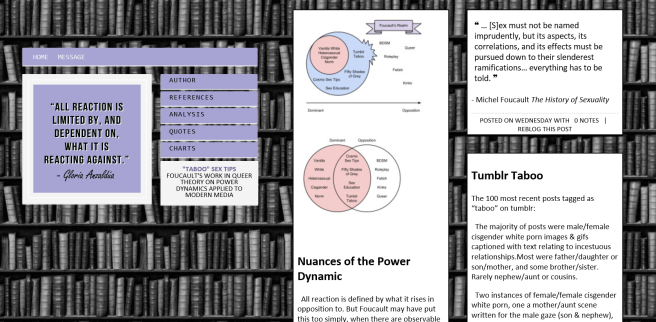
Enjoy!
Ho4Foucault: “Taboo” Sex Tips
A Tumblr Blog by Cal Keeter
Foucault’s work in queer theory on power dynamics applied to modern media
http://ho4foucault.tumblr.com/

Enjoy!
Queer Revisited: Gaga Feminism & the Heteroflexible Family
At the beginning of my experiences in a Queer Theory class, one work that impacted me greatly was the collection of stores in GenderQueer, specifically one tale of a lesbian woman coming to a new understanding of sexuality through the transition of her butch spouse to a transgender male husband.
The study that Halberstam references on female desire I found related strongly to the story. When female participants, heterosexual and lesbian alike, viewed a arousing images of multiple male, female, or heterosexual pairings their bodies reacted, stimulated by the content. The same array of images shown to heterosexual and gay men did not elicit a uniform reaction, rather the gay men only reacted to gay pairings while the straight men did not react to the gay pairings.
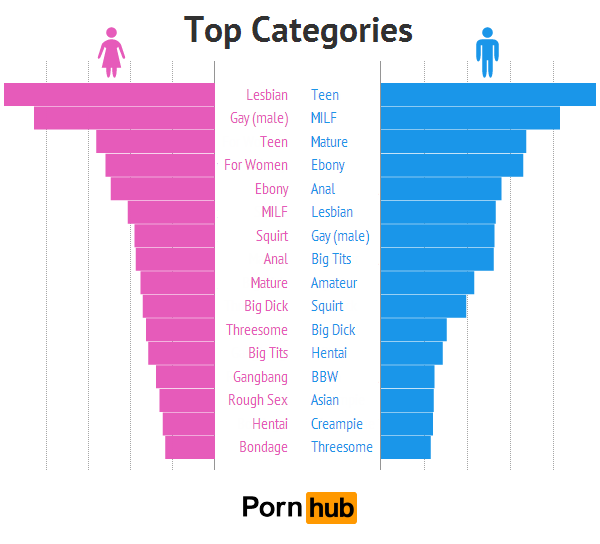
Halberstam frames these results to suggest that women have a flexibility to sexuality in the terms of “gender of object choice”, a categorization brought to light in an article referenced in an earlier blog post on bisexuality (GBT Studies and Queer Theory: New Conflicts, Collaborations, and Contested Terrain). Is Halberstam suggesting through their interpretation of this research that women may all be bisexual?
Another more overt tie to a work I previously posted about is Halberstam’s continuous references to Foucault’s work. They refer to Foucault’s analysis of the prison system when discussing Gaga’s “Telephone” music video, and again when discussing the pathological treatment of distinct and characteristic sexualities. This categorization of the hard-to-define concept of queerness mirrors the categorization of the similarly hard-to-define varieties of mental illnesses. Labels can serve or limit a person, potentially a simultaneous effect. Halberstam clarifies,
“When inflexibility does occur in femle desire (a disinclination for penetration, say), we speak of a pathological fixivity. When inflexibility appears in male desire (a disinclination for penetration, say), we speak of a normal range of erotic interest.
The construct of labels may be limiting heterosexual women from exploring attraction to other expressions of masculinity outside of cisgender and straight men, as well as limiting men to block themselves off from even subconsciously physically articulating any desire for different genders expressions. In redefining hetero, as Hetero: Queering Representations of Straightness attempted to do, it may be essential to open up heteroflexible as the norm that has existed always yet remains unnamed.
Works Cited
Dickson, EJ. Pornhub Search Statistics. Digital image. The Daily Dot. Daily Dot Medi, 22 Sept. 2014. Web. 2 May 2016.
Foucault, Michel. The History of Sexuality. New York: Pantheon, 1978. Print.
Griffin, Sean. Hetero: Queering Representations of Straightness. Albany, NY: SUNY, 2009. Print.
Halberstam, J. Jack. Gaga Feminism: Sex, Gender, and the End of Normal. Boston: Beacon, 2012. Print.
Lovaas, Karen, John P. Elia, and Gust A. Yep. LGBT Studies and Queer Theory: New Conflicts, Collaborations, and Contested Terrain. New York: Harrington Park, 2006. Print.
The same photographer, the same studio, the same backdrop, the same framing. Two things differ: subject and pose
A white woman, even with her musculature and pinned short hair, stands reclined (oxymoron) and dipped into a sensuous S curve. Her arms circle above her like a halo and the open yonic symbol guides the viewer’s gaze down her body. Even with her genitals modestly hidden by shadow, her lidded eyes express docile sexuality.
A Black man, even when adorned with long hair and a simple necklace, stands erect and posed aggressively. No shadow artfully conceals his protruding genitals, and his feet stationed far apart reflect a warrior’s stance. His gaze is affixed off camera, unwavering in its intensity.
How does one account for these differences? A white man, Robert Mapplethorpe, photographed a white woman and Black man. Everyone is raised in a prejudiced society, it’s what we do with those prejudices that reflects who we are. Who is Mapplethorpe?
Taking the entirety of Mapplethorpe’s work into consideration, it’s impossible to definitively call him a racist. There are instances however, (such as this one) where his sensitivity to race and gender did not show enough to be excused of fault.
Mapplethorpe’s images of Black males reiterate the ‘terms of colonial fantasy’ and ‘service the expectation of white desire.’
The fantasy is not only one of giant erect penises, but also one of hypersexual hypermasculine presence. While this mythical Black prowess terrifies the straight white male, it arouses the gay white male. This shift in effect is arguably no better than the former as it upholds the same myths and has it’s own dehumanizing effect in fetishization.
Both positions, whether they overvalue or devalue the visible signs of blackness, inhabit the same space of colonial fantasy.
The Black male is treated as an aggressor, and a fellow museum-goer pointed out to me the similarity this pose has to the walking progression of evolution. This further elaborates on dangerous myths about Blackness, relating to Social Darwinism and the belief that white people are the most evolved race.
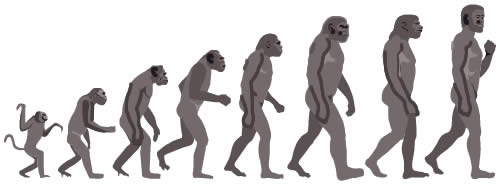
Imagine a photoset where the poses of the models are reversed. A Black male allowed to be graceful and soft, or a white woman allowed to be assertive and hard. Though this may clash with Mapplethorpe’s sexuality and artistic style, why does it have to?
While this small sampling of Mapplethorpe’s work exhibits racist and sexist tones, these are toned down when his work is observed as a whole. But “death of the author” says that the work should stand alone apart from the artist’s intentions.Perhaps “death of the context” also must come into play for one to see each piece outside the shielding of its portfolio or curated collection.
The controversial tones come to light then, and can be examined without need for prefacing an analysis with “Mapplethorpe’s not a racist but…” because a person, extreme in their racism or not, can still craft racist messages through art wholly independent of any intention.
Works Cited
Hemphill, Essex. “Does Your Mama Know About Me?” Ceremonies. New York: Plume, 1992. 37-42. Print.
Mapplethorpe, Robert. Lisa Lyon. 1982. Paul Getty Trust, Los Angeles.
Mercer, Kobena. “Looking for Trouble.” Transition 51 (1991): 184-97. JSTOR. Web. 25 Apr. 2016.
Patterson, Roger. Human Evolution. Digital image. Answers in Genesis. Answers in Genesis, 2 May 2007. Web. 25 Apr. 2016.
Biology is a Lot More Fishy Than You Realize
The film XXY has a lot of realness to it, and a principal theme is that of confusion. Human nature can be interpreted as a desire to know everything and with as much certainty as possible. The father in the movie works as a marine biologist, a profession that requires a generous helping of curiosity about the world. He works with patching up the turtles at the beginning, showing that he values not only knowing the intricacies of animal life but correcting the pain, and fixing what’s wrong with them.

Alex’s words and behaviors indicate that she feels like another specimen in the household. Her comment to Alvaro indicates that he cannot know all the species of her home, possibly seeing herself as one of the species entirely cut off from the more easily divided members of humanity. She wears a tracking tag for a turtle around her neck, a symbol of how the people in her life, her parents especially, have tracked her and tried to fix her up at every turn.
When Alex’s father meets with another intersex person, an adult who transitioned into their gender of male at the same age as Alex, he’s seeking a new approach to the questions he was trying to answers scientifically about his child’s gender. The answer was one he certainly didn’t want to hear, that he’d made his own child feel like a mistake, a disappointment, and to quote Alex, a monster.
I have the greatest sympathy for the Kraken family, and specifically Alex. The tragic dynamic of “normal” parents and “abnormal” child that they overprotect and misguidedly attempt to help plays out time and time again. The “abnormality” can be sexuality, gender, physical disability or mental disability. Sometimes combinations of them. Parents can be the first to hurt their children rather than help them.
The sexual assault of Alex makes the fears of the family must more palpable. Her parents know their child isn’t wholly safe where they’ve settled, and may not be truly safe anywhere.

But through listening to Alex and other intersex people, rather than the views of cisgender people, they begin to fight with her rather than against her. It will be a long process, even at the film’s end Alex’s father opens his mind to the idea that Alex may want to transition to male, but struggles with the concept of her never choosing to fully commit to one binary gender but rather identify solely as intersex, perhaps even proudly as intersex.
Works Cited
Mel. Trans coat of arms. Digital image. Cyaneus’ Art Blog. Tumblr, 2015. Web. 28 Mar. 2016.
XXY. Dir. Lucía Puenzo. Cinéfondation, 2007.
Straight Queer, Queer Straight, Who Do We Appreciate? Goooo Queers!
Straight queers:
These people exist with “straight passing” relationships and experiences. They can relate to straight media and aren’t exposed to the same amount of hate as other expressions of queerness are. But the aromantic hetero may find more in common with gay, lesbian, and bi aromantics because of the romonormative culture in America with tremendous focus on marriage. Likewise, the asexual hetero can find solace with aces of any orientation due to the pressures of sexual practice in society.
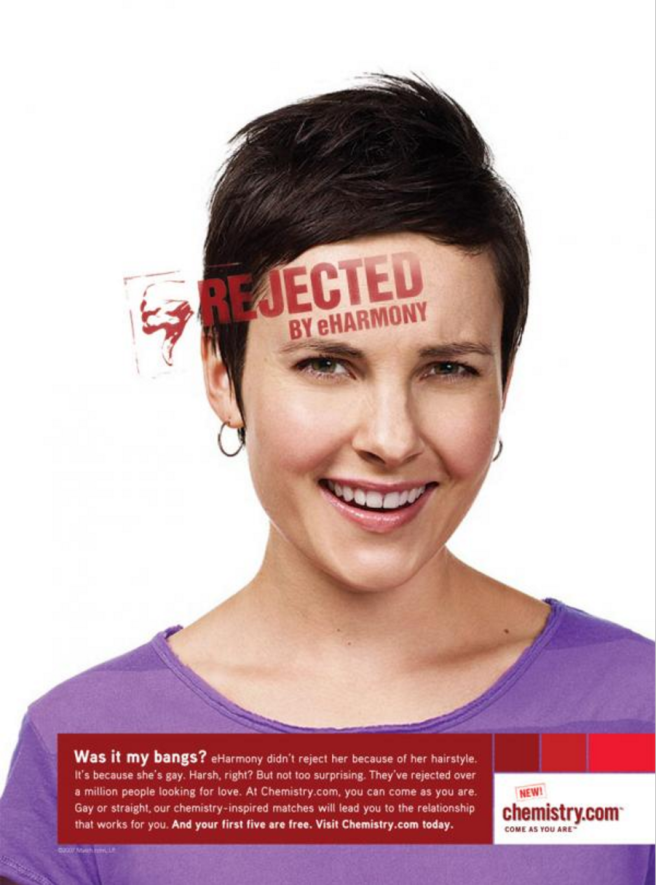
People attracted to multiple genders unquestionably have access to the term queer, while some queer monosexuals may wish to exclude them from queer spaces due to the invasion of a different gender relationship into a space. This exclusion serves to judge a person based on their current partner rather than on their individual experiences as a queer person
The polyamorous straight relationships could be argued to be just another product of a culture where men are expected to have many female sexual partners and women are expected to devote themselves to one man, such as in fundamentalist Mormon polygamy and other religious forms of polygamy. There are complex and multilayered poly relationships that exist in webs such as below where multiple adult partake in child raising and there is no upholding of the hetero norm of one man one woman.
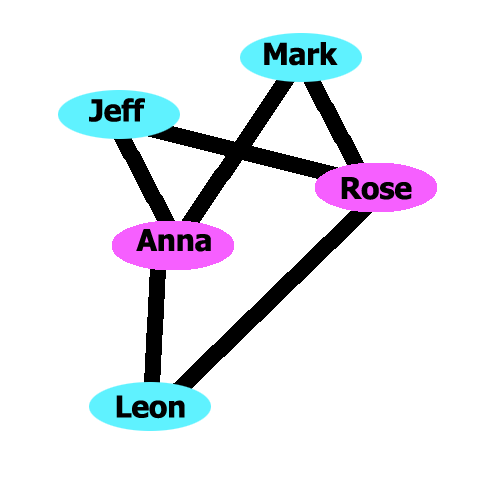
Queer straights:
A close friend’s older sister falls into the first two categories listed. Her and her boyfriend of 7 years are in their late twenties, but will not be marrying or having/raising children. This is not due to parental dislike of her chosen partner, or any infertility/sterility, or their socioeconomic background. It is merely a personal choice.
The film ends with the orgy of heterosexual iconography… the bride and groom kiss, the assembled guests applaud… flowers cover the charred altar [and] the wounds to the institution of heterosexual marriage begin their process of healing.
The family relations with the unmarried woman are strained now. My close friend, the younger daughter, has been explicitly told by her mother that duty of providing a son-in-law and grandchildren falls to her now.
Grey zone:
Both of these options are becoming more popular in media as well as gaining cultural acceptance. The divorce rate climbs upward, and few religious organizations seek to ban the end of a marriage (contrary to many who oppose the start of a new marriage between same gender partners). Single parents are often of lower socioeconomic status and pity is given to them, on the assumption that they would be a heterosexual two parent household if only they had the money and time to seek romance.
Works Cited
Griffin, Sean. Hetero: Queering Representations of Straightness. Albany, NY: SUNY, 2009. Print.
Raboy, Hanft. Rejected by eHarmony. Digital image. Coloribus. Lixil Graphics Ltd., June 2007. Web. 14 Mar. 2016.
Being Bi in Choice-based Games and RPGs: It Doesn’t Have to be Difficult
In these types of video game, the player is crucial to the construction of the story. How the game plays out is different for every person because we all make different choices, and do the same things in different ways.
So why is it so hard for a player’s character to be bisexual? Why is it so hard for other characters within these games to be bisexual?
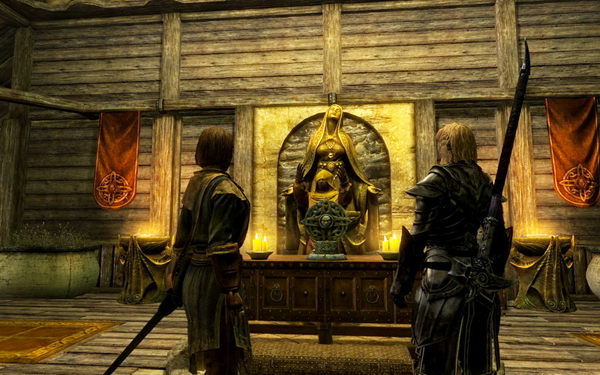
First, let’s look at a few examples of video games where it actually is easy and unproblematic to be bi. In the latest installments of Bethesda’s Elder Scrolls series and Fallout series, all marriage/relationship options are available to a player of any gender. While relationships are very limited in Skyrim, the quests and dialogue for Fallout characters is much greater. Fallout 4 goes beyond gender of object preference by allowing the player character to be polyamorous as well. A character could have two separate romances with characters of 2 different genders, not canceling out the other at any point in the game.
It’s simple, why code for gender locked marriage partners when it’s so much easier to leave it open to any gender of player? Representation in video games is so simple when you’re a lazy coder. In the Fallout series, npc characters are often randomly generated from the available races and genders playable. This leads to a surprisingly diverse cast in post-apocalyptic America, where black women and asian men fight alongside each other as tribe members and anyone can succeed in the wasteland as a small business owner.
…bisexuality can both ‘foreground gender in analyses of identity, sexuality, desire, and pleasure-and thereby highlight the interconnections of gender and sexuality’ and ‘it can also displace gender as the primary mans for understanding certain forms of identity, sexuality, desire, and pleasure’
The lazy coder’s approach to inclusion of bisexuality in video games clearly displaces gender, making gender so obsolete to the in-game characters that there is no need to identify the sexuality of their characters. The player in Fallout: New Vegas only has the option of flirtatious dialogue with a gender of npc after selecting the corresponding perk. Two perks are needed for the full range of bisexual flirting, making it more difficult to obtain than simply homo or hetero flirting.

Choice-based games can be a lot more personal, because you are given a character to play as and the scope of choices is more limited. In Dontnod’s Life is Strange, the player controls Max Caulfield, a high school senior at a prestigious private school located in a crumbling fishing town on the Oregon coast. This game deals with choice in a novel way, giving Max limited time travel powers so she may test out each choice’s short term effects before committing to them. The crux of the story is Chloe, Max’s childhood best friend that she recently reconnected with by using time travel to save her life.
Max’s journal in the player menu fills out as the story progresses, and her inner monologue sounds off in-game. Through this, the fans of this game have gathered some hints to Max’s sexuality. This is vital to many, as the player can choose to engage in romantically coded moments (agreeing to dates, kissing) with either Chloe, or another one of Max’s friends Warren.
The facts:

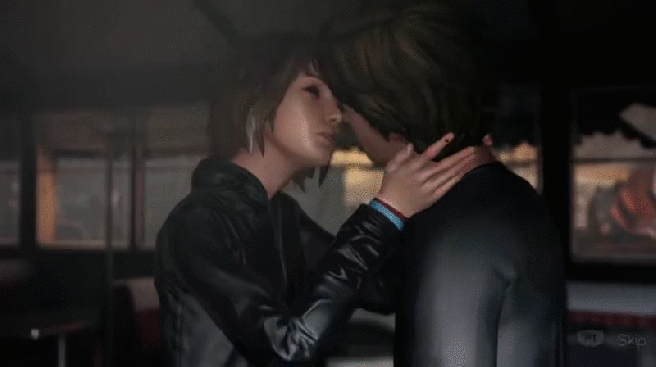
Lesbian fans: Max was raised in a heteronormative society, she was socialized into thinking that she had to find men attractive, she is a repressed and closeted lesbian who finds Warren’s advances flattering but unwelcome, choosing to kiss Chloe is the right way to play the game
Straight fans: Max is confused about her sexuality, and that’s normal and fine. She really does like Warren and just isn’t in the right place to be with him at the game’s start, but their relationship develops through trusting him more and more in the course of the game. Chloe is a great friend to Max, but truly they are just friends.
Bisexual fans: You can’t confine Max’s sexuality to either monosexual alignment. The presence of two choices at all means that both options are valid to Max, making her attracted to people of all genders. There are flaws to the lesbian argument and to the straight argument, and the facts clearly show that attraction to both genders is present and denial of either as “false” goes against the canon.
The distinction between gender-specific and non-gender specific sexuality is embodied in, and essentialized by, the concept of the ‘monosexual’ who, unlike the ‘bisexual’, restricts her or his sexuality partners of only one sex or the other.
So what is it? The creators have publicly stated that there is no wrong way to play the game. But how much does creator’s intent shape the work once it is in the hands of the audience? In a similar case, the creators of Dragon Age 2 publicly claimed that their cast of characters you can romance are “playersexual” rather than bisexual, implying that they fall in the dichotomy of hetero or homo depending on which gender the player chooses to be. This is problematic is erasing the possibility of bisexuality in these beloved characters.
Life is Strange puts gender at the foreground of sexual preference, while other games displace it. Pitting bisexual representation against monosexual lesbian or gay representation creates divisions in LGBTQ+ fanbases, and may ultimately be more destructive than constructive to a queer identity. This whole debacle may just prove how limiting labels can be, and that appreciating expressions of sexuality for what they are is better than trying to dissect them.
Works Cited
Four Fallout series perk illustrations. Digital image. Fallout Wiki. Wikia, n.d. Web. 7 Mar. 2016.
Hogan, Heather. Two women getting married in Skyrim. Digital image. After Ellen. Totally Her, 18 June 2014. Web. 7 Mar. 2016.
Lovaas, Karen, John P. Elia, and Gust A. Yep. LGBT Studies and Queer Theory: New Conflicts, Collaborations, and Contested Terrain. New York: Harrington Park, 2006. Print.
Skeleton. Max Caulfield kissing Chloe Price in Life is Strange. Digital image. Pokemon Reborn. IP Board 3.4.6, 29 Jan. 2013. Web. 7 Mar. 2016.
Wolfenus53. Max Caulfield kissing Warren Graham in Life is Strange. Digital image. Telltale Games. Telltale, Incorporated, 22 Oct. 2015. Web. 7 Mar. 2016.
A Little Party Never Killed Nobody
Rural Oregon is one small part of the home I know, and this connection lent true weight to Clare’s story for me. My grandparents are those rednecks, I stayed at their redneck ranch in southwest Oregon for weeks of childhood summer. When they drive up north to my suburbs, they leave behind a “Put Christ Back in Christmas” bumper sticker that will never come in contact with my mom’s navy blue sedan.

In the midst of the reality that Clare crafts about southwest Oregon, he weaves in striking criticism of today’s picture of queer in his novel Exile and Pride. The city makes the gay, the showiness, modernity, and materialism is what makes you gay. How do you prove your queerness without the clothes to match, or the rainbow patterned anything?
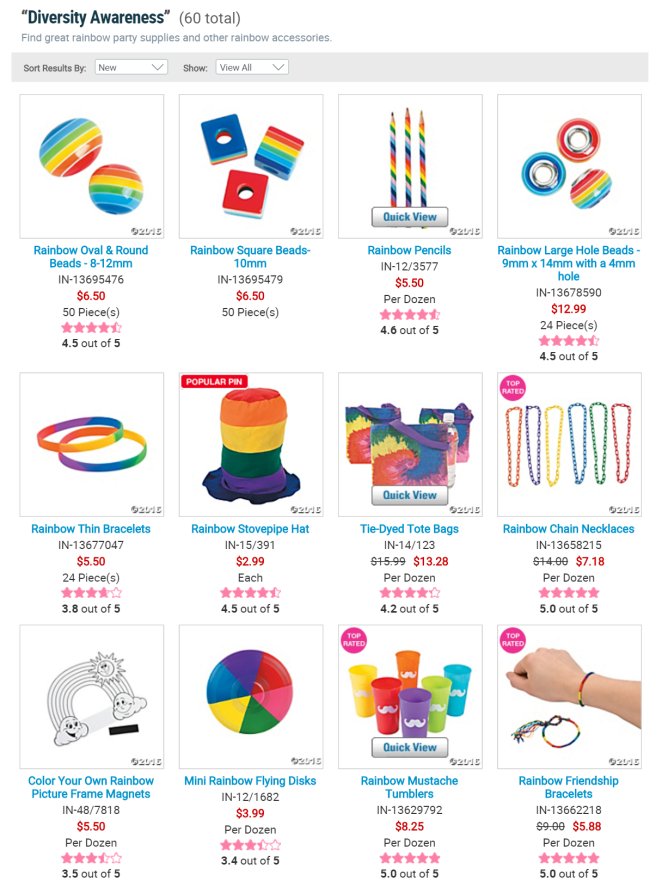
The only parades in rural Oregon are on the 4th of July, where the county firefighters lead the way and are followed by the church groups holding banners advertising their Sunday worship agenda. There is no pride, and as Clare described earlier on page 34, the allowance of queerness in the landscape hangs in precarious balance. From page 43 in the book:
Why does the money that creates Stonewall 25 and events like it rarely find its way to working-class and poor queers? Why does the money stay urban?
Is the capitalist queer a queer at all, by definition? Participation in the commodification of queerness drives mainstream acceptance up and funding for the programs Clare says we need, “AIDS prevention programs, LGBT youth services, hate-crime monitoring, and queer theater in the mountains of rural Oregon, the cornfields of rural Nebraska, the lowlands’ of rural South Carolina”.
Is a queer kid more likely to be “born this way” in a city or in the country? By population density, it may be more economical simply to concentrate the locus of queer in urban environments. Clare made it out to the city to discover his dykeness, if she can why not everyone else? As his description of Stonewall 25 show, the queer community generates the funds to go beyond urban projects, they go and throw urban parties. Maybe after a tough day of fighting a heteronormative cisnormative society we could use a little party, but how far do invitations spread? To the poor, the rural, the disabled?
…The homophobic violence they face–dead dogs in their mailbox, gunfire at night–no longer makes the headlines…
To not pay attention to one aspect of the queer experience is to do a disservice to queerness entirely, as the power of a queer identity is in its reaching scope. Clare’s love for the overlooked and interwoven grayness of his experiences create a touching narrative and a call to action.
Works Cited
Bruckman, John. C2 Ranch. Digital image. Southern Oregon Land Conservancy. N.p., 2011. Web. 29 Feb. 2016.
Clare, Eli. Exile and Pride: Disability, Queerness and Liberation. Cambridge, MA: South End, 1999. Print.
XXX 18+ For Mature Eyes Only FORBIDDEN LOVERS
One of the most striking things that Foucault has to say about sexuality is how society continues to create and maintain it’s own taboo. Even though Foucault was writing about power and pleasure 40 years ago, the stifled relationship that the western world has with sex remains.
The assumption: Experiencing pleasure contradicts power structures dictating the norms of sex (one penis-holder and one vagina-bearer in the missionary position, where the man achieves orgasm for the purpose of expelling semen in order to impregnate the woman). By participating in the scandalous and sexy we are freeing ourselves from an oppressive norm.
The reality: As a society we cling fervently to the notions of normalcy and abnormalcy in order to exist within the power structure and derive pleasure from a capture and release game played through brushes with the taboo, as Foucault writes on page 45.
Capture and seduction, confrontation and mutual reinforcement… these attractions, these evasions, these circular incitements have traced around bodies and sexes, not boundaries not to be crossed, but perpetual spirals of power and pleasure.
There doesn’t exist a social norm without the deviant, and there doesn’t exist the deviant without the social norm. Foucault proposes that playing the role of the deviant does not make one any more progressive than existing within the norm. Efforts to normalize what was once deviant only create a new picture of deviance, never breaking down the binary.
Today we see the same patterns in media of scandal played out. “Cosmo Sex Tips” up the heart rates of 40-something mothers waiting in beauty salons, 50 Shades of Grey draws crowds and sparks hushed conversation, supernatural or dystopian romances such as Twilight and The Hunger Games add the coveted red warning label of forbidden upon an otherwise everyday totally normal white cis hetero relationship.
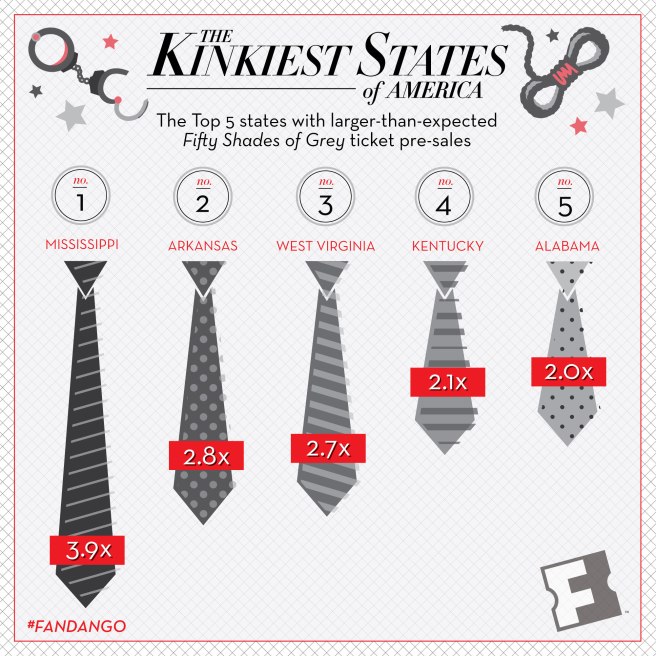
Everyone craves the rush of excitement that comes from being a bit naughty. Just a touch raunchy. And yet we never seek to understand why these practices come with all the fuss. As Foucault explains, we seek to treat sex with cold medical formality, scientia sexualis, or bask in the lewdness of defying that rigidity. Another approach, ars erotica, upholds pleasure itself while not making a big deal about what is right and what is wrong, just about what is felt.
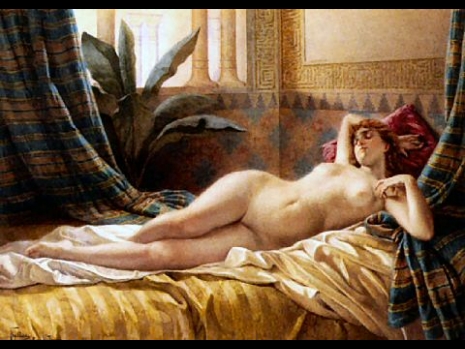
You can visit any museum in the world and find erotic art displayed bare without warning. You can visit any porn website online and find it categorized, industrialized, bodies acting out parts to fit your every taboo. You can visit any middle school classroom across the country and listen to the fits of giggles in a health lesson that mentions sexual health, but you’ll also hear the disappointed shushing of the teacher.
In the book 1984, the main character in a dystopian future is locked in a loveless marriage with unfulfilling sex. It’s an adventure to have an affair with his coworker, a younger woman, and escape to the countryside to make love. They steal away to an abandoned attic and join a resistance movement against their authoritarian government. The ending (spoiler warning for a book that came out decades ago) reveals that every aspect of their deviance had been orchestrated and allowed by the government all along, building up their individuality in order to torture it out of them and create more truly loyal citizens of them both.

Are we not just feeding into the industry of taboo and sexual scandal? If it’s not the government tracking and egging on our deviance, might it be the commercial capitalist economy where books like 50 Shades of Grey can lead to sales in sex toys, movie tickets, porn subscriptions, and all sorts of ways to indulge oneself in a society that is so clearly no longer held to a power structure of sex like those prissy Victorians?
Works Cited
Ballesio, Francesco. Liegende. N.d. Oil Painting Online. Xiamen RuoYa Arts And Crafts Co., Ltd. Web. 22 Feb. 2016.
Cowan, Matt. 1984 Book Cover. Digital image. DeviantArt. DeviantArt, 2 Sept. 2011. Web. 22 Feb. 2016.
Fandango. INFOGRAPHIC: ‘FIFTY SHADES OF GREY’: DID YOUR STATE PREORDER THE MOST TICKETS? Digital image. Fandango. Fandango, 12 Feb. 2015. Web.
Foucault, Michel. The History of Sexuality. New York: Pantheon, 1978. Print.
Adventures With Queer Prince Charming
“Loving Outside Simple Lines” is a story featured in the book Genderqueer, and this blog post tells a personal tale in response to that.
The book’s story follows a couple through their relationship as one partner’s experience with gender shifts toward expression as a transgender man after previously expressing butch lesbianism. This throws his partner for a loop, as she struggled to identify as a lesbian and now feels an identity crisis over her spouse no longer being comfortable with womanhood.
There is a sort of fairy tale ending for the couple, as the man goes through surgery and comes out the other side confident in new ways, and the woman finds new open-mindedness concerning gender and sexual orientation.

I am now going to expose myself as a truly sappy individual: I got choked up a bit reading this. Maybe because I read it on Valentine’s Day, maybe because it sounds like the kind of rom coms I wish I could watch instead of the same boring cisgender heterosexual white people over and over again. Maybe because the story sounds something like what I experienced at a much younger age. It’s story time, gather round.
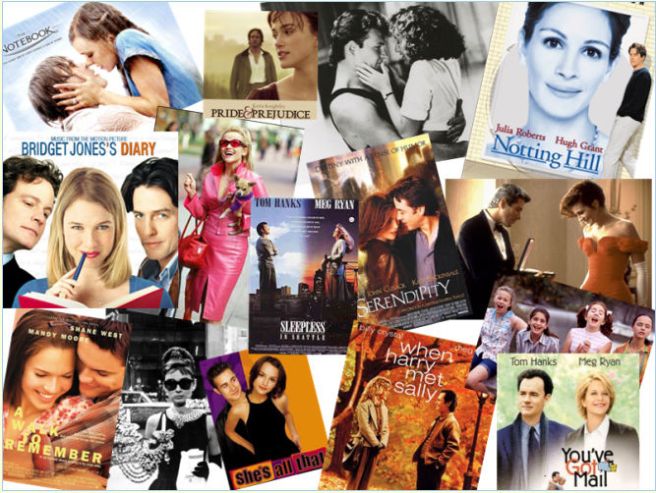
The Internet Made Me Gay
One of the most transformative relationships I have cultivated in my short lifetime started in my sophomore year of high school. Allow me to introduce you to my favorite blogging website, Tumblr.com.
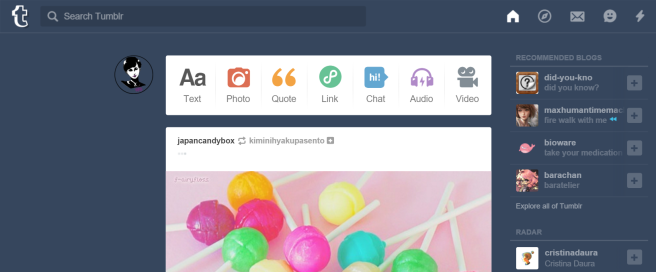
What this blogging website allowed me to do, at age 15, was meet someone from the other side of the world. I met a girl from Brazil.

We were into all the same books and video games, so we grew to be the kind of best friends who IM’d after I got home from school every day and stayed up all night on the weekends having video chat sleepovers. I was one of the first people to see her new haircut, the pixie style looked incredible on her.
One day she said she had a weird question for me, something that was really personal to her. She asked to be called by a different name, and different pronouns.
Somewhere within me it clicked, as I had always seen him in baggy shirts layered over too small tank tops to conceal his chest. The way he fit so naturally in with his brothers and shriveled whenever his mother asked him to wear a skirt or dress to a family event.
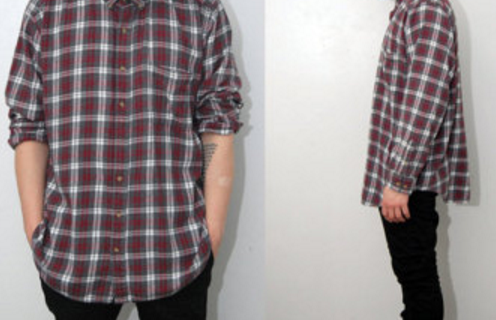
I explained this to my offline friends, in delicate terms. They had already gotten used to the fact that I was intricately close with someone too far away to even be conceived by pre-internet generations. It was always a queer relationship in that way, mainstream society had raised me with the warning that the internet was full of creepy old men and to stay away.
After many years of friendship we got together romantically for a while, our own little fairy tale for just a few months (as many youthful dalliances bloom and wilt swiftly). I know I credit a lot of comfort with my sexuality to his own gender exploration in a way. My queer prince charming gave me a sense of identity in the same way the man in “Loving Outside Simple Lines” helped the author with hers.
I had worried throughout middle school and high school about losing my dearest female friends when they found out I was interested in pursuing love affairs with people of their gender. Making friends with a trans boy and finding other LGBTQ+ friends through him gave me that first taste of a community who would always welcome me, whether or not mainstream society ever could.
I often bless this path you have taken, for your own sake and for mine; it has propelled me into my own journey, and I have found a part of me which needed to emerge. I see people, the world, differently. I am different.
Befriending him gave me strength and stability that I had never known. The story of “Loving Outside Simple Lines” connected me again to that source of togetherness we shared from hemispheres apart. I loved him as a girl and as a boy, as a friend and as a boyfriend, traversing time and space to extend personal acceptance in the face of an unaccepting world. We could use more modern fairy tales like that.
Works Cited
Ghost Vintage. Vintage 90s Men’s Button up Plaid Flannel Shirt. Digital image. Ghost Vintage. Etsy, 2 Apr. 2015. Web. 15 Feb. 2016.
Mittal, Charu. Collage of romantic comedy movies. Digital image. Campus Diaries. Campus Diaries, 26 Jan. 2014. Web. 15 Feb. 2016.
Mosser, Scott. Double Incision Top Surgery with Free Nipple Grafts. Digital image. FTM Surgery Network. Trans Media Network, 8 Jan. 2016. Web. 15 Feb. 2016.
Nestle, Joan, Clare Howell, and Riki Wilchins. GenderQueer: Voices from beyond the Sexual Binary. Los Angeles: Alyson, 2002. Print.
Plano Piloto, Adam. The city of Brasilia. Digital image. World Cup Portal. Brazilian Federal Government Website on the 2014 FIFA World Cup, May 2013. Web. 15 Feb. 2016.
Facets of Identity Formation: Queerness and Race
A fascinating debate within Nikki Sullivan’s book A Critical Introduction to Queer Theory is the question of how identity and action come to be. In the context of homosexuality, this draws upon ideas of nature versus nurture while also introducing a third element: choice.
Do individuals have an innate identity? Is that innate identity like a putty, brought into form by a cultural mold? Was there no putty, but only an emptiness within us that the mold of culture was set around and filled externally up with substance? Is it possible to break our mold?
In the preliminary chapters of Sullivan’s work, she describes how the perception of homosexual tendencies have shifted throughout history. While homosexuality continues to be violently othered, there exist certain benefits for holding one idea about core self over another.
As Gaga proclaims in her hit “Born This Way” that races, genders, and sexual tendencies are all part of an innate self that remains unchangeable in the context of culture.
This rhetoric shields individuals from the backlash of groups that vilify homosexuality and gender subversion, but has the upsetting implication that people would choose to be rid of their homosexual tendencies if they had the option as Sullivan addresses on page 30 of the book.
Later on page 89, discussion of nature versus nurture versus choice addresses how any choice that exists in gender and sexual practice is confined to the limits of historical precedence. Earlier on page 82, the text introduces one perspective of gender and thus identity as
“…acts and gestures which are learned and are repeated over time [to] create the illusion of an innate and stable (gender) core.”
To perform gender, are we also performing all other aspects of our identities as humans? Sullivan’s chapter titled “Queer Race” begins on page 57 with the history of scientific racism, also known as Social Darwinism. Once it is clear that race does not come attached with particular identity attributes, can it be claimed that race is performed?
Race can be treated similarly to queerness, as respectability and assimilation rhetoric encourages adoption of the social norm, in this case being white culture.
Why do you have to wear your hair like that? Why don’t you try skin lightening cream for your complexion? Why don’t you get plastic surgery to avoid unwelcome stares?
These questions make participation in race seem like a choice. To some degree it is a choice to wear an afro hairstyle, to use chemical straightening treatments, or to have a weave. On the other hand, these choices exist within a historical framework that pressures black people into making this choice. The texture for hair is written in DNA, and is thus unalterable.
Beyoncé’s newest video “Formation” champions black pride while proclaiming that it’s not simply a choice, but ties into her parentage and bloodlines, with a connections to the locations and cultures of her upbringing.
Experiencing the many cultural differences in queerness lends support to the idea that our perceptions of self can never completely break free of culture, whether by means of choice or by means of realizing the innate and truest self.
Ellen Page’s new documentary “Gaycation” seeks to understand the worldwide dimensions of queerness and explore beyond ideas of white American western gayness. Notable quotes include an individual claiming to not fit the west’s conception of transgender, and Page’s comment on how no one would ever choose to face the oppression that one does for homosexual behavior and gender subversion.
Is Ellen Page saying that an LGBTQ+ identity and homosexual behavior is not a choice? Or is she saying that it cannot be a choice in today’s world due to the presence of oppression and violence?
Works Cited
Formation (Dirty). Perf. Beyoncé Knowles. Youtube. Tidal, 6 Feb. 2016. Web. 8 Feb. 2016.
Lady Gaga – Born This Way. Prod. Vincent Herbert. Dir. Nick Knight. Perf. Lady Gaga. Youtube. Vevo, 27 Feb. 2011. Web. 8 Feb. 2016.
Sullivan, Nikki. A Critical Introduction to Queer Theory. New York: New York UP, 2003. Print.
(Trailer) GAYCATION with Ellen Page and Ian Daniel. Perf. Ellen Page and Ian Daniel. Youtube. Viceland, 26 Jan. 2016. Web. 8 Feb. 2016.